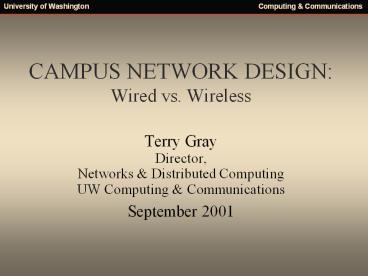CAMPUS NETWORK DESIGN: Wired vs. Wireless PowerPoint PPT Presentation
Title: CAMPUS NETWORK DESIGN: Wired vs. Wireless
1
CAMPUS NETWORK DESIGNWired vs. Wireless
- Terry Gray
- Director,
- Networks Distributed Computing
- UW Computing Communications
- September 2001
2
Scope of UW Networking
- UW Campus Networks
- Seattle
- Tacoma
- Bothell/CCC
- Medical Centers (net design)
- UW Physicians Network
- UW Medical Center
- Harborview Medical Center
- Pacific/NorthWest Gigapop
- Pacific Wave exchange point
- Pacific Light Rail
- Statewide K20 Network
3
Pacific Northwest Gigapop
4
Baseline Connectivity
- Shared 10Mbps HD
- Switched 10Mbps HD
- Switched 10/100Mbps FD
- backed by GE switch/router infrastructure
- Goal Switched 10/100 FD for all GE for a few
- Reality Cat3 wireplant upgrade will take
multiple years and multiple millions of dollars
5
Advanced Services
- Multicast
- Partially deployed
- Older routers need to be replaced
- QoS
- Laissez faire? Premium service?
- Best with FD connections.
- VoIP
- Needs QoS, extra-high availability
- POE desirable implies UPS in closets
- IPv6
6
Premium Services?
- Wide-area QoS chargeback?
- Preferred access to Internet for a fee?
- Lots of interesting policy and tech issues...
7
Mistakes We Didn't Make
- FDDI to the desk
- VLANs
- ATM
- Various "cut-thru IP switching" digressions
- Claim Staying with pure IP and Ethernet has
served UW very well...
8
Current Statistics
- Avg Backbone traffic nearly 2 TB/day
- Peak Inbound traffic 100 Mbps (40 in 1999)
- Peak Outbound traffic 160 Mbps (20 in 1999)
- Doubling time Less than 2 years!!
- Hosts over 50,000
- Modems over 2,000
- Switched subnets 70 (30 in 1999)
- 10/100 FD subnets 25 (5 in 1999)
- Cat 5 buildings 10
9
UW-S Building/Subnet Status
10
GigE Buildings
- part of Electrical Engr.
- part of HS K wing
- part of HS T wing
- part of Johnson Hall
- part of Savery
- part of Thomson Hall
- part of 4545
- Physics/Astronomy
- Fisheries Center
- new Ocean
- Lander Hall
- McCarty Hall
- Parrington Hall
- Edmondson Pavillion
- Mary Gates Hall
- OUG Library
11
Simplified Network Topology
Core Switch
Gigapop
4
Fed Nets
Border Router
Internet2
Router
Router
30
Internet
Interior Switch
Interior Switch
300
PBX
Edge Switch
Edge Switch
1000
Branch Site
50,000
Desktop
Desktop
12
13
Number of Devices
14
Backbone Traffic
15
Border Traffic 1999
16
Border Traffic 2001
17
Recurring Theme Explosive Growth
- More users
- More devices
- Longer use
- New (bandwidth-intensive) applications
- e.g. remote collaboration tools
- audio/video streaming
- tele-immersion
- distance learning
18
Networking Hot List
- Campus building/subnet upgrades
- Backbone upgrades (production, experimental)
- Regional networking
- Network Hardening
- Security
- Advanced Services
- Wireless
- Management/diagnostic tools
19
Success Metrics
- 10/100 FD connections xx
- Multicast deployment xx
- QoS deployment xx
- Deptl wireless coverage xx
- Router center hardening xx
- Backbone capacity
- IPv6 capable routers
20
On to Wireless...
21
Wireless Categories
- Wireless by Purpose
- Point-to-Point links
- Access networks
- Wireless by Spectrum
- Infrared
- RF
- Optical
22
Wireless RF by Range
- PAN/HAN (Personal/Home-Area-Network)
- Bluetooth
- HomeRF
- LAN (Local-Area-Network)
- IEEE 802.11
- ETSI HiperLAN2
- MAN (Metro-Area-Network)
- LMDS, Fixed Wireless
- WAN (Wide-Area-Network)
- Ricochet (R.I.P.)
- CDPD
- 2.5G, 3G, etc, etc, etc
23
LAN Wireless Standards
- IEEE 802.11 2.4GHz, 1-2Mbps, FHSS, DSSS
- IEEE 802.11b 2.4Ghz, 11Mbps DSSS (WiFi)
- IEEE 802.11a 5Ghz, 54Mbps
- ETSI HiperLAN2 5Ghz, 54Mbps, TDMA
- In US, all use unlicensed ISM bands
24
802.11 ISSUES
- Network Design, esp. Topology
- Access control
- Security
- Compatibility
- Interference
- Relation to Bluetooth, HomeRF, etc
- Obsolescence
25
ROAMING ISSUES
- Layer 2 (802.11) vs. Layer 3 (Mobile IP)
- Vendor incompatibility
- LAN vs. WAN
- We will support L2 roaming within a building by
dedicating one subnet for all access points in
the building.
26
Policy Issues
- Part of campus network infrastructure
- Want to encourage small-scale deployments with
minimum overhead, but coordination needed to
avoid interference - Large-scale deployments need to be coordinated by
CC - Campus-wide access control policy
27
UW-S Wireless Deployment
- CC Pilot Project
- Kane Hall, Rm. 130
- Mary Gates Hall
- Gerberding Hall
- Odegaard Undergraduate Library
- Other wireless projects
- CS, CC, Business, MCIS, ...
28
Pilot Project Objectives
- Provide 11 Mb coverage throughout selected
facilities. - Allow roaming within facility space.
- Develop suitable policies.
- Gain operational experience.
29
Pilot Project Lessons Learned
- Success depends on cooperation w/depts
- It takes more wire than you think!
- Site surveys frequency sweeps needed.
- WEP is not secure use SSH, SSL, etc.
- Technology still evolving
- 2.4GHz phones interfere badly
30
Wired vs. Wireless Issues
- Server suitability
- Performance
- Performance variation
- Price/Performance
- Interference
- Technology maturity
- Advanced services
- Security
31
802.11a Successor?
- Faster
- Shorter distance
- More power consumption
- Probably wont replace 802.11b
- Probably need WAPs for both
32
Infrastructure Requirements
33
Conclusions
- Wireless is very addictive.
- It will be very popular.
- It will be very problematic.
- The dust has not settled.
- In offices, it is not a replacement for wired.
- In classrooms, lounges, etc, it is but that
still requires some wired infrastructure.
34
Wireless References
- Open Group www.openwirelessdata.org
- Wireless Ethernet Compatibility Alliance (WECA)
- Wireless LAN Association (WLANA)
- Portable Computer Communications Association
(PCCA) - Internet Engineering Task Force (IETF)
- WAP Forum
- Bluetooth Special Interest Group
- Mobile Wireless Internet Forum (MWIF)
- Wireless Information Networks Forum (WINForum)
- HiperLAN2 Global Forum
- Wireless Data Forum

